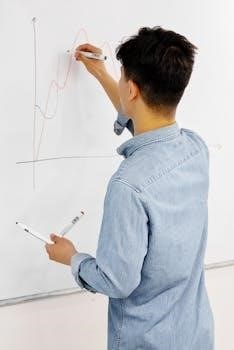What is a Potty Training Chart?
A potty training chart is a visual tool, often a printable document, used to track a child’s progress in learning to use the toilet. It usually includes blocks for marking successes with stickers or markers, providing positive reinforcement.
Definition and Purpose of a Potty Training Chart
A potty training chart is essentially a template, often printable, designed to monitor a child’s journey towards toilet independence. Its main purpose is to visually represent progress, usually through stickers or markers, motivating the child and reinforcing positive behaviors. These charts help both parents and children track successes, providing a clear picture of the child’s achievements and the path ahead during potty training.
Benefits of Using a Potty Training Chart
Potty training charts offer motivation and positive reinforcement, aiding in tracking progress and identifying patterns. These tools make the process fun and rewarding for children.
Motivation and Positive Reinforcement
Potty training charts serve as a fantastic tool for motivating children by visually representing their achievements. Using stickers or markers to mark successes gives children a sense of accomplishment and encourages them to continue their efforts. The charts act as a positive reinforcement system, associating potty training with fun and rewards, making the process more engaging and less daunting for the child.
Tracking Progress and Identifying Patterns
Potty training charts are invaluable for tracking a child’s progress over days or weeks, providing a clear picture of their journey. These charts allow parents to record details like time of day, successes, and accidents, which can help identify patterns. This can be useful in recognizing when a child is most likely to need the toilet, enabling better planning and proactive support during the training process.
Types of Potty Training Charts
Potty training charts come in various forms, including sticker charts, reward systems, and themed charts. These can feature diverse designs like farm animals, space, cars, or popular characters to engage children.
Sticker Charts and Reward Systems
Sticker charts are a popular method, where children earn stickers for successful potty attempts, which they then place on the chart. These charts often work in conjunction with a reward system. For example, a small prize or treat is given after accumulating a certain number of stickers, thus making the potty training process more motivating and enjoyable for the child, using positive reinforcement to encourage continued progress.
Themed Charts (e.g., Farm, Space, Cars)
Themed charts add an element of fun and personalization to the potty training process by incorporating designs and characters that appeal to children. Popular themes include farm animals, outer space, and vehicles like cars. These charts can feature related images and colors, making the reward system more engaging and encouraging for the child. Themed charts cater to different interests.
Free Printable Potty Training Chart Templates
Numerous websites offer free, printable potty training chart templates. These templates come in various designs and formats, often as PDF files, making them easily accessible for parents to download and use.
Where to Find Free PDF Downloads
Many parenting websites, blogs, and educational resource platforms offer free printable potty training charts in PDF format. These resources often provide a variety of themes and designs, catering to different children’s interests. You can find them by searching online using terms like “free potty training chart printable” or by looking through parenting forums and websites dedicated to early childhood education. These downloadable resources are generally easy to access and print at home.
Customizable Options and Features
Many printable potty training charts offer customizable features. These might include the ability to add your child’s name, select different background colors or themes, and choose from various clip art characters or illustrations. Some templates allow you to adjust the number of days or rows for tracking progress. Furthermore, some digital options offer editable text fields, enabling you to personalize the chart to fit your specific potty training goals.
How to Use a Potty Training Chart Effectively
Effective use involves actively including your child in the process. Consistency and patience are key, along with positive reinforcement for each successful potty attempt or related behavior.
Involving Your Child in the Process
Engage your child by letting them choose the chart’s design, background, and characters. Allow them to place stickers or mark their successes themselves on the chart. This sense of ownership can significantly increase their motivation and enthusiasm for potty training. Make it a fun, collaborative activity, not just a task they have to complete, ensuring their buy-in.
Consistency and Patience
Consistency is key when using a potty training chart. Ensure you’re using the chart every time and follow the same routine. Patience is equally crucial; potty training takes time, and setbacks are normal. Avoid getting frustrated; instead, offer encouragement and positive reinforcement consistently. Remember, every child progresses at their own pace, and the chart is a tool to support, not pressure them.

DIY Potty Training Chart Ideas
Creating your own chart allows for personalization. Use your child’s favorite characters or themes. Involve them in the making process for increased engagement and excitement.
Creating a Personalized Chart
Personalizing a potty training chart involves tailoring it to your child’s specific interests and preferences. This could include using their favorite cartoon characters, animals, or colors. You can also incorporate themes they enjoy like space, cars, or mermaids. Allowing your child to choose the design elements makes the process more engaging and motivates them to participate actively. This boosts their enthusiasm for potty training.
Using Everyday Materials
Creating a DIY potty training chart can be simple and inexpensive by utilizing everyday materials found around the house. A large piece of paper or cardboard can serve as the chart base. Stickers, markers, crayons, and even small toys can be used to track progress. You could also use a sheet protector for reusability with dry-erase markers. Involving your child in decorating and creating the chart adds a personal touch.

Potty Training Chart Design Elements
Potty training chart design should consider layout and structure, making it easy to track progress. Visual appeal, using child-friendly colors and characters, is important for engagement and motivation.
Layout and Structure Considerations
When designing a potty training chart, consider using a clear and simple layout. Rows can represent days, while columns might track successes, accidents, or specific actions like sitting on the potty or washing hands. Include space for stickers or stamps. The structure should be easy for both the child and parent to understand, promoting consistent use and clear tracking of progress. Some charts use horizontal displays, while others use vertical.
Visual Appeal and Child-Friendly Designs
Potty training charts should be visually appealing to children. Use bright colors, fun characters, and themes that resonate with the child’s interests, such as farm animals, space, or popular characters like Spiderman or mermaids. Including familiar clip art and allowing the child to participate in the design process can increase their motivation and engagement with the chart. A child-friendly design ensures a more positive experience.

Using Potty Training Charts with Different Ages
Potty training charts can be adapted for toddlers and preschoolers. Modifications are also possible for children with special needs, ensuring the tool is effective for various developmental stages and individual needs.
Adapting Charts for Toddlers and Preschoolers
For toddlers, simple charts with large, clear visuals work best, focusing on basic actions. Preschoolers might engage with charts that track more complex routines. Themed charts, like those featuring cars or mermaids, can boost interest and motivation, making the process more engaging for different age groups. Adjusting the reward system to fit the child’s understanding is also crucial for success.
Modifications for Children with Special Needs
Potty training charts for children with special needs may require specific modifications. Visual schedules with clear, step-by-step instructions can be helpful. Charts might need larger spaces for stickers or be adapted to track specific skills and behaviors related to toileting. Using fewer steps on the chart and ensuring that it is easy to understand and physically accessible are key for success.
Troubleshooting Common Potty Training Challenges
Potty training setbacks can happen; use the chart to identify patterns. Adjust the charting strategy if needed, focusing on consistency and positive reinforcement to address challenges effectively.
Using the Chart to Address Setbacks
When potty training setbacks occur, the chart can be a valuable tool for analysis. Examine the chart for patterns, such as increased accidents at certain times of day. This helps pinpoint potential triggers or challenges. Use the visual record to discuss setbacks with your child in a calm, supportive manner. Adjust the chart or reward system if needed to refocus and encourage progress;
When to Adjust the Charting Strategy
Observe your child’s reaction to the chart. If they become uninterested or discouraged, it’s time to adjust. Consider changing the reward system, altering the chart’s design, or shifting the focus to different aspects of potty training. If progress stalls, re-evaluate the goals and make modifications to better suit the child’s needs and development. Flexibility is key.

Potty Training Chart as a Tool for Success
Potty training charts are a valuable tool that can be combined with other methods. They aid in tracking progress, celebrating milestones, and creating a positive association with toilet training.
Combining Charting with Other Training Methods
Potty training charts work best when integrated with other strategies. They are not a standalone solution. Combining them with consistent routines, positive verbal encouragement, and age-appropriate books or videos can significantly enhance the learning process. Charts provide visual feedback, while other methods offer different types of support and guidance. This multi-faceted approach can help children grasp the concept of potty training more effectively and confidently.
Celebrating Milestones and Achievements
Recognizing and celebrating milestones is crucial for positive reinforcement. When a child achieves a goal on their chart, such as successfully using the potty or staying dry, celebrate enthusiastically. This could involve small rewards, verbal praise, or a special activity. These celebrations reinforce the positive behavior and motivate them to continue their progress. It also makes the potty training experience more enjoyable and less stressful for the child.